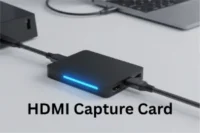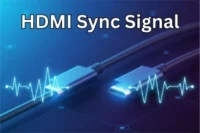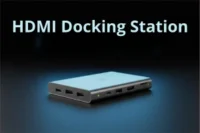HDMI vs USB-C: Simple Comparison Guide
Published: 29 Aug 2025
Hey there!
- Have you ever wondered which is better: USB-C or HDMI?
- Do you need both, or can one replace the other?
- Which one is best for gaming, work, or watching movies?
If you’re confused about USB-C vs HDMI, you’re not alone! Both are popular, but they serve different purposes.
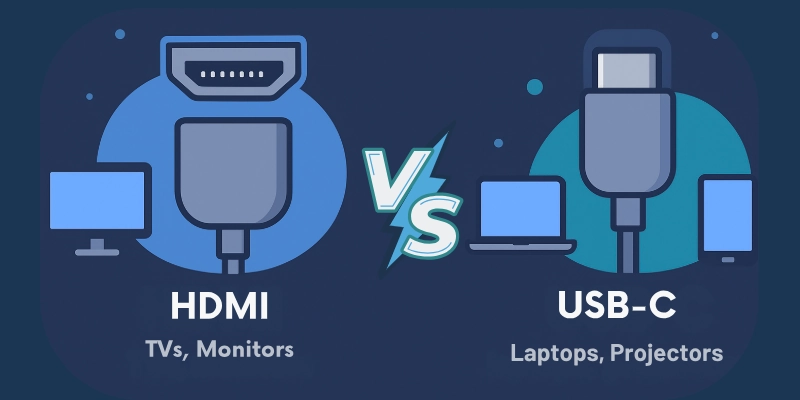
In this guide, I’ll break difference between USB-C and HDMI so that you can easily decide which one suits your needs best.
Let’s get started!
What Makes HDMI and USB-C Different?
Before we talk about the differences, let’s understand what HDMI and USB-C do.
HDMI stands for High-Definition Multimedia Interface. It is mainly used to send video and audio. You will find it on TVs, gaming consoles, projectors, and monitors. It gives high-quality picture and sound without any extra setup.
USB-C is a newer and more flexible port. It can transfer data, connect displays, and charge devices. Unlike HDMI, USB-C works no matter how you plug it in. It is mostly found in laptops, tablets, and smartphones.
Now that we know the basics, let’s compare them to find the best option for you.
USB-C vs HDMI: Key Differences
Guys, here I have come up with seven comparison points to help you understand the differences between these two types of connections (hdmi and usb-c).
The list of differences is here:
- Connector Type & Design
- Video & Audio Quality
- Data Transfer & Multi-Functionality
- Power Delivery Capabilities
- Device Compatibility
- Gaming Performance
- Reliability and Durability
Let’s go right into our major topic of discussion.
1. Connector Type & Design
Before diving into deeper comparisons, let’s first understand how USB-C and HDMI differ in their shape, design, and functionality.
USB-C:
- Compact and slim – Easily fits into modern, lightweight devices.
- Reversible design – You can plug it in from any side, and it will still work.
- Multi-purpose – Supports video, data transfer, and power delivery all in one cable.
- Widely used in laptops, tablets, smartphones, and docking stations.
HDMI:
- Larger and bulkier – Takes up more space on devices.
- One-way connection – Must be plugged in a specific direction.
- Built for video and audio only – Does not transfer data or charge devices.
- Commonly found on TVs, gaming consoles, projectors, and monitors.
These design differences affect how each port is used.
2. Video & Audio Quality
Now, let’s compare USB-C and HDMI in terms of video and audio performance to see which one delivers the best quality.
USB-C:
- Supports high resolutions – Can handle 4K at 60Hz and even 8K, but it depends on the device and cable version.
- Uses DisplayPort or Thunderbolt technology – Offers great video quality when connected to compatible screens.
- HDR (High Dynamic Range) support – Provides better colors and contrast for a more detailed picture.
- Audio support varies – Can carry audio, but not all USB-C ports are designed for it.
HDMI:
- Optimized for video and audio – Standard choice for TVs, gaming, and home theaters.
- Handles up to 8K – Newer HDMI versions (like HDMI 2.1) support 8K at 60Hz and 4K at 120Hz for smooth visuals.
- Better HDR and color depth – Delivers richer colors and deeper contrast, especially for movies and games.
- Built-in audio support – Supports surround sound and advanced audio formats like Dolby Atmos.
Both USB-C and HDMI offer high-quality video, but HDMI is the better option for home entertainment and gaming, while USB-C is more flexible for laptops, monitors, and portable devices.
3. Data Transfer & Multi-Functionality
Now, let’s see how USB-C and HDMI compare when it comes to data transfer and extra features.
USB-C:
- Transfers files – Can move data between devices like a USB drive.
- Supports charging – Can power laptops, phones, and accessories.
- Works with DisplayPort Alt Mode – Can send video to external screens.
- Multi-purpose port – One cable can charge, transfer data, and connect displays.

HDMI:
- Only for video and audio – Cannot transfer files or charge devices.
- No data transfer – Not designed for sending files or connecting storage devices.
- Does not provide power – Unlike USB-C, it cannot charge devices.
- Best for media use – Ideal for TVs, projectors, and gaming.
USB-C is the better option for all-in-one use, while HDMI is best when you only need to connect a screen for media playback.
4. Power Delivery Capabilities
Now, let’s compare how USB-C and HDMI handle power and charging.
USB-C:
- Supports Power Delivery (PD) – Can charge laptops, phones, and other devices.
- Fast charging – Some USB-C cables can deliver up to 100W or more.
- Single-cable solution – Can charge, transfer data, and send video all at once.
HDMI:
- Does not provide power – Cannot charge devices or transfer power like USB-C.
- Only sends video and audio – No support for charging laptops or phones.
- HDMI ARC/eARC exception – Can send audio back from a TV to a soundbar, but not for charging.
USB-C is the clear winner for power delivery, making it ideal for laptops, tablets, and phones, while HDMI is focused only on media transmission.
5. Device Compatibility
Let’s see which devices work best with USB-C and HDMI and how they connect to different screens.
USB-C:
- Common in modern devices – Found in new laptops, MacBooks, tablets, and some smartphones.
- Works with monitors – Can connect to USB-C and DisplayPort monitors directly.
- Requires adapters – If your monitor only has HDMI, you’ll need a USB-C to HDMI adapter.
- Popular in docking stations – Many USB-C docks let you connect multiple monitors and devices.
HDMI:
- Standard for home entertainment – Found in TVs, gaming consoles, projectors, and older laptops.
- Best for direct display connection – No adapter needed if your monitor, TV, or projector has an HDMI port.
- Limited to video/audio – Cannot transfer data or power like USB-C.
- Adapters available – You can use HDMI to USB-C adapters, but they don’t support charging or data transfer.
If you’re using a monitor with USB-C, a USB-C cable is best. If your screen only has HDMI, then HDMI is the better choice—or you’ll need an adapter.
6. Gaming Performance
Let’s compare USB-C and HDMI for gaming and see which one works best.
USB-C (via DisplayPort Alt Mode):
- Can support high refresh rates – Works with 144Hz, 165Hz, or even higher refresh-rate gaming monitors.
- Supports 4K gaming – If your device has DisplayPort 1.4 over USB-C, it can handle 4K at high FPS.
- Great for gaming laptops – Many modern laptops use USB-C for external displays.
- Compatibility varies – Not all USB-C ports support video output, so you need to check your device.
- May need adapters – If your monitor only has HDMI, you’ll need a USB-C to HDMI adapter.
HDMI:
- Best for gaming consoles – PlayStation, Xbox, and gaming PCs rely on HDMI connections.
- Supports 4K at 120Hz – HDMI 2.1 allows high-resolution, high-refresh-rate gaming.
- VRR (Variable Refresh Rate) – Reduces screen tearing for a smooth gaming experience.
- Low latency – Optimized for fast response times, making it great for competitive gaming.
- Limited to video/audio – Unlike USB-C, HDMI cannot transfer power or data.
For gaming laptops and high-refresh-rate monitors, USB-C can be a good option if it supports DisplayPort. And, for gaming consoles, TVs, and most gaming monitors, HDMI is still the best choice.
7. Reliability and Durability
Let’s see how USB-C and HDMI compare in terms of stability and long-term use.
USB-C:
- More advanced but not always reliable – Some USB-C cables don’t support video output, which can cause confusion.
- Compact and reversible – Easier to plug in, but ports can wear out over time due to frequent use.
- Quality varies – Not all USB-C cables are the same; you need to check if they support power, data, and video.
HDMI:
- Highly stable and widely used – TVs, gaming consoles, and monitors have relied on HDMI for years.
- Durable and long-lasting – HDMI cables are thicker and less prone to damage compared to USB-C cables.
- Larger and non-reversible – Can only be plugged in one way, but this design makes it less fragile.
For reliability, HDMI is the better choice as it is stable and widely supported.
USB-C is great for flexibility but requires high-quality cables for the best experience.
When to Use USB-C vs HDMI?
Here’s when you should choose USB-C or HDMI based on your needs:
Use USB-C if:
- You need one cable for power, data, and video.
- You have a modern laptop, tablet, or smartphone that supports USB-C video output.
- You want a compact and reversible connector.
- You need to connect to a USB-C monitor.
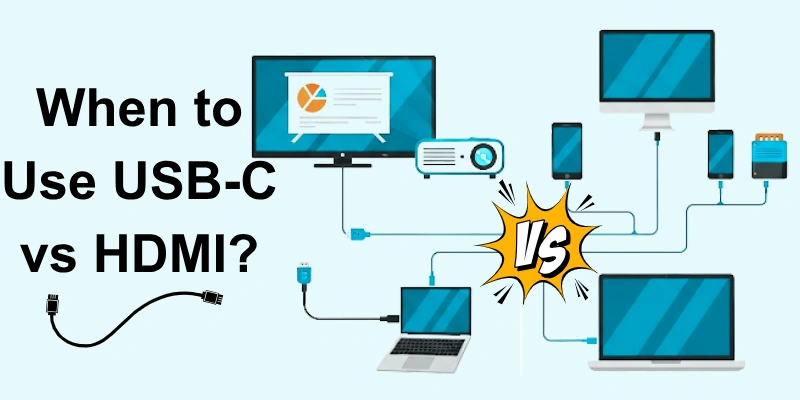
Use HDMI if:
- You are connecting to a TV, gaming console, or projector.
- You want stable video and audio transmission.
- Your device does not support USB-C for video output.
- You need high-quality gaming performance with HDMI 2.1 features.
Both options have their benefits, so choose based on what works best for your setup!
Special Cases & Comparisons
Sometimes, you might come across unique situations where you need to decide between USB-C and HDMI.
Let’s go over some special cases.
Mini HDMI vs USB-C
- Mini HDMI is a smaller version of HDMI, often found on cameras, tablets, and small devices.
- USB-C is more versatile, as it can transfer data, power, and video, while Mini HDMI only handles video and audio.
- If your device supports USB-C video output, it’s usually a better choice over Mini HDMI.
HDMI Port vs USB Port
- HDMI ports are designed only for video and audio.
- USB ports (especially USB-C) can charge devices, transfer files, and send video if they support DisplayPort Alt Mode.
- If you only need to connect a monitor or TV, HDMI is fine. But if you need power and data transfer, USB-C is the better option.
HDMI or USB-C for External Monitors
- USB-C is great for modern monitors, especially if they have a USB-C port for video and power.
- HDMI is best for traditional monitors and TVs that don’t support USB-C.
- If your laptop only has USB-C, you may need an adapter to connect to an HDMI monitor.
Conclusion
We’ve covered USB-C and HDMI, explaining how they differ in design, performance, and compatibility. You now know when to use USB-C for multi-functionality and when HDMI is the better choice for media and gaming.
Going forward, USB-C is growing in popularity, especially for laptops and mobile devices, while HDMI will continue to dominate home entertainment. Each has its place, and the right choice depends on what you need.
Thanks for reading—happy connecting!
FAQs
Here are some of the most commonly asked questions related to the difference between HDMI and USB-C:
HDMI is better than USB-C only for direct video and sound use. It’s reliable for TVs, projectors, and monitors. But USB-C is more advanced and has more features. It can replace HDMI in many cases. Still, HDMI is simple and widely used.
USB Type-C is better because it is a multi-use port. It supports charging, data, audio, and video—all in one. It’s small, reversible, and works with phones, tablets, and laptops. It’s future-ready and reduces the need for many cables. That’s why it’s used in most modern devices.
USB-C may replace HDMI in many modern devices. Since it supports video and audio like HDMI, plus power and data, it’s more flexible. Many laptops and phones now use USB-C for display too. But HDMI is still widely used, so full replacement may take time. For now, both are used together.
Not yet! USB-C can do video, power, and data, but HDMI is still the best for TVs and gaming. Many new devices use USB-C, but most screens still need HDMI. You may need an adapter to connect them. For now, both are important.
No, if you use a high-quality adapter. A good USB-C to HDMI cable supports 4K and even 8K. Cheap adapters might cause flickering or low refresh rates. Always check specs before buying.
It depends! HDMI 2.1 can go up to 48Gbps, while USB-C with Thunderbolt 4 reaches 40Gbps. But USB-C also transfers data and power, not just video. If you need pure video speed, HDMI is better.
Yes, but check your device. If your USB-C supports DisplayPort Alt Mode, it can do 4K 60Hz or more. But HDMI 2.1 is better for high refresh rates and gaming features. For serious gaming, HDMI wins.
No, HDMI only sends video and audio. USB-C can charge laptops, tablets, and phones while sending video. Some HDMI ports (ARC/eARC) power soundbars, but not other devices. If you need power and video in one cable, USB-C is better.
Both work, but HDMI 2.1 is best for 4K 120Hz. USB-C can do 4K, but not all cables support it. If you want top performance for movies or gaming, go with HDMI. For laptops and work, USB-C is great.
Some top brands are Anker, Belkin, UGREEN, and Cable Matters. Get one that supports 4K at 60Hz or higher. If your device has Thunderbolt 3 or 4, choose an adapter that works with it. Always check reviews before buying!

- Be Respectful
- Stay Relevant
- Stay Positive
- True Feedback
- Encourage Discussion
- Avoid Spamming
- No Fake News
- Don't Copy-Paste
- No Personal Attacks

- Be Respectful
- Stay Relevant
- Stay Positive
- True Feedback
- Encourage Discussion
- Avoid Spamming
- No Fake News
- Don't Copy-Paste
- No Personal Attacks


